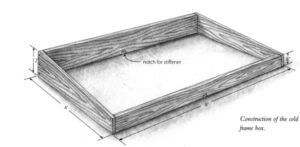Get a Jump on the Planting Season: Build Your Own Cold Frame
The trees are bare and the ground is cold, hard, and forbidding in New England. If you’re an amateur gardener who wants to grow your own food, it can be a little intimidating. There are plenty of hardy plant breeds that will grow in winter, or you can do something a little more fun and science-y. For centuries, farmers and gardeners have used a simple device called a cold frame to extend their growing season by using the natural heat and light of the sun to keep plants healthy and warm with relatively little effort or expense.
The following is an excerpt from Four-Season Harvest by Eliot Coleman. It has been adapted for the web.
Gardeners should dedicate a monument to the cold frame. It is the simplest, most flexible, and most successful low-tech tool for modifying the garden climate. It’s simple because it is basically a box with a glass top and no bottom that sits on the soil. It’s flexible because it can be made as long, as wide, or as tall as the gardener wishes. And it’s successful because it is a tried-and-true garden aid that has been used in one form or another since ancient times (sheets of mica predated glass). The cold frame was the foundation for the early development of intensive commercial horticulture.
How the Cold Frame Works
The cold frame lessens climatic stress in a number of ways:
Temperature. A single layer of glass creates a microclimate in which the nighttime temperature inside the frame can be as much as 20° warmer than the temperature outside, although the average difference is 7° to 10°F The daytime temperature inside the frame, even on a cloudy, early spring day, will be 10° to 15°F warmer than outdoors. On a sunny spring day, the temperature can rise high enough to cook the soil and the plants if you don’t vent off the extra heat. Both daytime and nighttime temperature differences depend on the time of year, the angle and intensity of the sun, the rate of outdoor temperature change, and the initial temperature in the frame.
Moisture. Much of the havoc that freezing can wreak on winter vegetables is a function of how wet the plants are. High humidity helps protect plants from cold but plants sitting in a puddled soil just soaked by a rain before freezing will be more stressed than one that is drier. The glass roof of the cold frame protects the crops inside from pounding winter rains.
Wind. The wind can make a cool day feel very cold. Weather forecasters always mention the windchill factor. The same conditions affect plants. Wind cools by removing ambient heat and evaporating moisture. The stress of winter wind alone can mean the difference between life and death for hardy vegetables. Even the slightest windbreak will help. That was proven by two beds of spinach planted a few Septembers ago to winter over outdoors. One was covered lightly with a mulch of pine boughs and the other left uncovered. Even though you could look through the thin layer of pine boughs and clearly see the spinach, that minimal amount of wind protection was significant. Ninety percent of the protected spinach survived the winter, compared to ten percent of the unprotected crop.
Building the Cold Frame
As previously mentioned, a cold frame is a bottomless box that sits on the soil and has a glass cover. Thus, there are two parts-the sides (the box) and the top (the glass). The sides can be made of almost any material-boards, concrete blocks, bales of hay, logs, and so on, all of which have their virtues. From our experience, we suggest making the sides out of boards. This will give you a frame that is long-lasting, easy to  construct, easy to use, reasonably light, and movable.
construct, easy to use, reasonably light, and movable.
The top covering is called a light. In the old days, lights were 4 to 6 feet square and made of overlapping panes of glass. They were heavy and required two people to carry them. Today’s home gardeners often use old storm windows as lights. Storm windows are easy to find and the size is right for covering cold frames. Modern lights can be glazed with translucent materials other than glass, such as plastic, polycarbonate, or fiberglass. Depending on its size, a cold frame is covered with one or more lights.
A cold frame can be any width that the lights will cover and any length or height. Traditional home garden cold frames measure 4 to 6 feet front to back and are 8 to 12 feet long. They are laid out with the long dimension running east to west. The frame should be just tall enough to clear the crops you plan to grow. In the standard design, the back wall is 12 inches high and the front wall 8 inches high, so that there is a slight slope to the south.
Some experimenters have built frames with the lights at a 45° angle facing south to maximize midwinter sun input. Such frames don’t work as well as the traditional low-angle models for two reasons. First, you don’t need maximum heat in midwinter for hardy crops. All they require is the protection of the frame. Second, there seems to be some benefit to having the glass roof near the plants as if it were a covering of snow. The environment inside the traditional low-angle frames better meets the needs of hardy crops.
Recommended Reads
Get a Jump on the Planting Season: Build Your Own Cold Frame, Part 2
Get a Jump on the Planting Season: Build Your Own Cold Frame, Part 3
